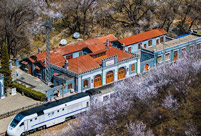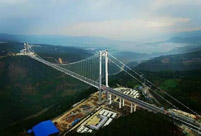

Karst landform in Jingxi city offers tourists spectacular natural views.[Photo provided to China Daily]
A special fund was arranged to develop the Xijiang River into a "golden waterway" to the Pearl River Delta, Hong Kong and Macao.
During the 2011-15 period, Guangxi accelerated subregional economic cooperation with the Pan-Beibu Gulf Zone and the Greater Mekong Subregion, speeded up construction of the Nanning-Singapore Economic Corridor and took part in negotiations on the proposed Regional Comprehensive Economic Partnership between China, ASEAN and other partners.
Guangxi now has an annual cargo handling capacity of more than 200 million metric tons in its Beibu Gulf sea ports and has established a China-ASEAN port cities network. It has opened air routes to major ASEAN cities and finished construction of the Nanning-Pingxiang high-speed road, the Guangxi sector of China's first expressway to Southeast Asia.
Since 2013, the region has accelerated infrastructure construction in ports along its borders, putting 55 projects on its agenda with total investment of over 230 million yuan ($35 million).
Guangxi has 25 dry, sea and river ports, including 19 national first-level open ports. Fangchenggang has navigable channels with more than 250 ports in over 100 countries and regions, and Qinzhou Port opened five direct trade routes to Hong Kong, Taiwan, Vietnam, Thailand and Singapore.
An increasing number of Guangxi companies tapped into overseas markets from 2011 to 2015.
 |  |
 French girl ties the knot with Chinese boy
French girl ties the knot with Chinese boy Beijing Style: ready for bare legs
Beijing Style: ready for bare legs Century-old station sees railyway evolution
Century-old station sees railyway evolution Enthusiasts perform Kung Fu at Wudang Mountain
Enthusiasts perform Kung Fu at Wudang Mountain Stunning photos of China's fighter jets in drill
Stunning photos of China's fighter jets in drill Monk's mummified body to be made into a gold Buddha statue
Monk's mummified body to be made into a gold Buddha statue Former Chinese solider of the French Foreign Legion seeks wife online
Former Chinese solider of the French Foreign Legion seeks wife online Asia's longest and highest suspension bridge to open to traffic
Asia's longest and highest suspension bridge to open to traffic China's first interactive robot looks like a beauty
China's first interactive robot looks like a beauty Top 20 hottest women in the world in 2014
Top 20 hottest women in the world in 2014 Top 10 hardest languages to learn
Top 10 hardest languages to learn 10 Chinese female stars with most beautiful faces
10 Chinese female stars with most beautiful faces China’s Top 10 Unique Bridges, Highways and Roads
China’s Top 10 Unique Bridges, Highways and Roads Can US win a new Cold War upon China?
Can US win a new Cold War upon China? China sitting on data goldmine
China sitting on data goldmine Experts say Sino-US space collaboration is likely to stay sci-fi
Experts say Sino-US space collaboration is likely to stay sci-fi Chinese NGOs receive less from overseas backers as new law stresses national security
Chinese NGOs receive less from overseas backers as new law stresses national securityDay|Week